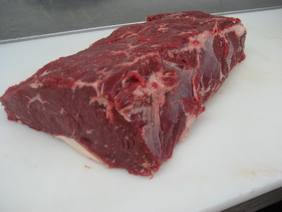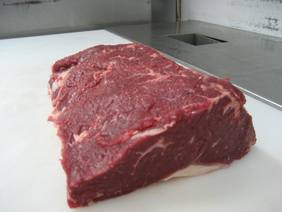Strip Loin Roast
(Top Loin Roast )
Strip Loin Roast
Flavor: 4 Out of 5
Alternate Names: Top Loin Roast, New York Strip Roast, Short-Cut Beef Loin

Cut from the short loin, the strip loin is the larger of two meats that make up the T-bone, the smaller tenderloin makes up the other side of the T-bone.
The strip loin steak or New York strip steaks are very a popular cut but not a lot of people roast this cut.
Strip loin is a tender cut with a nice beefy flavor and texture, that when cooked properly will receive rave reviews.
To bring out additional flavor and produce a more buttery texture you can dry age the roast for a few days.
Age the beef in the refrigerator by leaving it uncovered on a wire rack over a pan to catch the drippings for at least a day or as long as 3-4 days.
When you are ready to cook the roast, trim off any dried pieces after the aging. It is common for a roast to lose 5%-15% of its weight during the aging.
Strip loin roast can be cooked at different temperatures with different results. We discuss two ways that yield good results.
The first way is our favorite, there is a little more work involved and it takes a little longer but its worth it.
The second method is a quicker and easier method which will please most but not quite as juicy from center to outer edge.
Click Here For Grilling Strip Loin Roast
Cooking Instructions
Strip Loin Roast
Cooking Method 1
Many of the finest restaurants that serve strip loin roast use low temperatures to achieve those great juicy beefy flavors.
In our experience cooking at higher temperatures of the 350-450 degree range will cause a roast to dry out on the outer parts and shrink anywhere form 3/4 to 1lb or more depending on the size of the roast by the time its done cooking.
A low temperature of 250 degrees will cook roast beef evenly through from the center to the outer edge without any drying out, leaving the meat tender and juicy.
You might be concerned about the possibility of bacteria and it has been shown that cooking a roast this way is actually safe but to have piece of mind there is a way to solve this and at the same time give the roast a nice brown surface.
Bacteria grows from the outside and a way to get rid of bacteria is to sear the roast first. Searing the roast will seal in the juices and look very appealing when being served.
1. An hour before cooking, remove the roast from the refrigerator to bring to room temperature.
2. Preheat the oven to 250 degrees and set the rack to the lower middle position. Take a heavy bottomed roasting pan and set the pan on 1 burner or 2 burners if you have a large pan and set the temperature to medium-high.
Once the pan is hot sear the roast on all sides for 1.5 - 2 minutes per side. A large heavy skillet can also be used to sear the roast.
3. Carefully remove the roast, set a wire rack in centre of the roasting pan and place roast fat side up on the rack. Season with salt and pepper to taste and cook uncovered.
4. Roast the meat to a temperature of 135-140 degrees (medium-rare) for maximum flavor and tenderness or 140-150 degrees (medium) but no more, anything more will begin to dry out the roast.
Depending on the size of the roast it will take 25-30 minutes per pound, so you must have an instant-read thermometer to make sure you don't overcook. Remove roast from oven and tent with foil. Let it rest at least 15- 20 minutes to allow the juices to redistribute themselves evenly throughout the roast.
When cooking at 250 degrees the roast will only rise another 2-4 degrees or so during the resting time. Cut crosswise into 1/3-inch-thick slices. Arrange slices on platter and serve.
 |
Below is a cooking chart for roast beef recipe. Remember you should always use an instant-read thermometer to check the doneness of a roast. In method A because a temperature of 250 degrees is used the temperature will only rise about 2-4 degrees during resting time.
| Doneness | Description | Meat Thermometer Reading |
| Rare | Red with cold, soft center | 125-130 degrees |
| Medium-Rare | Red with warm, somewhat firm center | 135-140 degrees |
| Medium | Pink and firm throughout | 140-150 degrees |
| Medium-well | Pink line in center, quite firm | 150-155 degrees |
| Well-done | Gray-brown throughout and completely firm | 160-165 degrees |
Don't waste expensive leftover cuts of meat! Learn how to safely dehydrate it at Easy Food Dehydrating. Great for backpacking, and for long-term food storage.
Cooking Method 2
The second method is a non-risky way to cook a strip loin roast, it may not give you the most tender, juiciest roast but will still be a nice roast.
1. An hour before cooking, remove the roast from the refrigerator to bring it to room temperature.
2. Preheat oven to 450°F. Season with salt and pepper, place meat fat side up on rack in roasting pan uncovered. Roast meat 15 minutes.
3. Reduce oven temperature to 325°F and roast for about 15-18 minutes per pound.
Roast meat until instant-read thermometer inserted into thickest part of meat registers 135-140°F (medium-rare), which will give you maximum flavor and tenderness or 140-150°F (medium) but no more, anything more will begin to dry out the roast.
Remove from oven, tent with foil and let stand at least 15-20 minutes.
The internal temperature will rise about 5-10 degrees during resting time. Remove the strip loin roast 5-10 degrees before the desired doneness. Remember you should always use an instant-read thermometer to check the doneness of a roast.
Click Here To Go To Beef Steaks
Return To Top - Strip Loin Roast
US To Metric System Chart
Oven Temperatures
Fahrenheit (°F) Celsius (°C)
125° 52°
150° 66°
175° 80°
200° 93°
225° 107°
250° 121°
275° 135°
300° 149°
325° 163°
350° 177°
375° 190°
400° 205°
425° 218°
450° 232°
475° 246°
500° 260°




